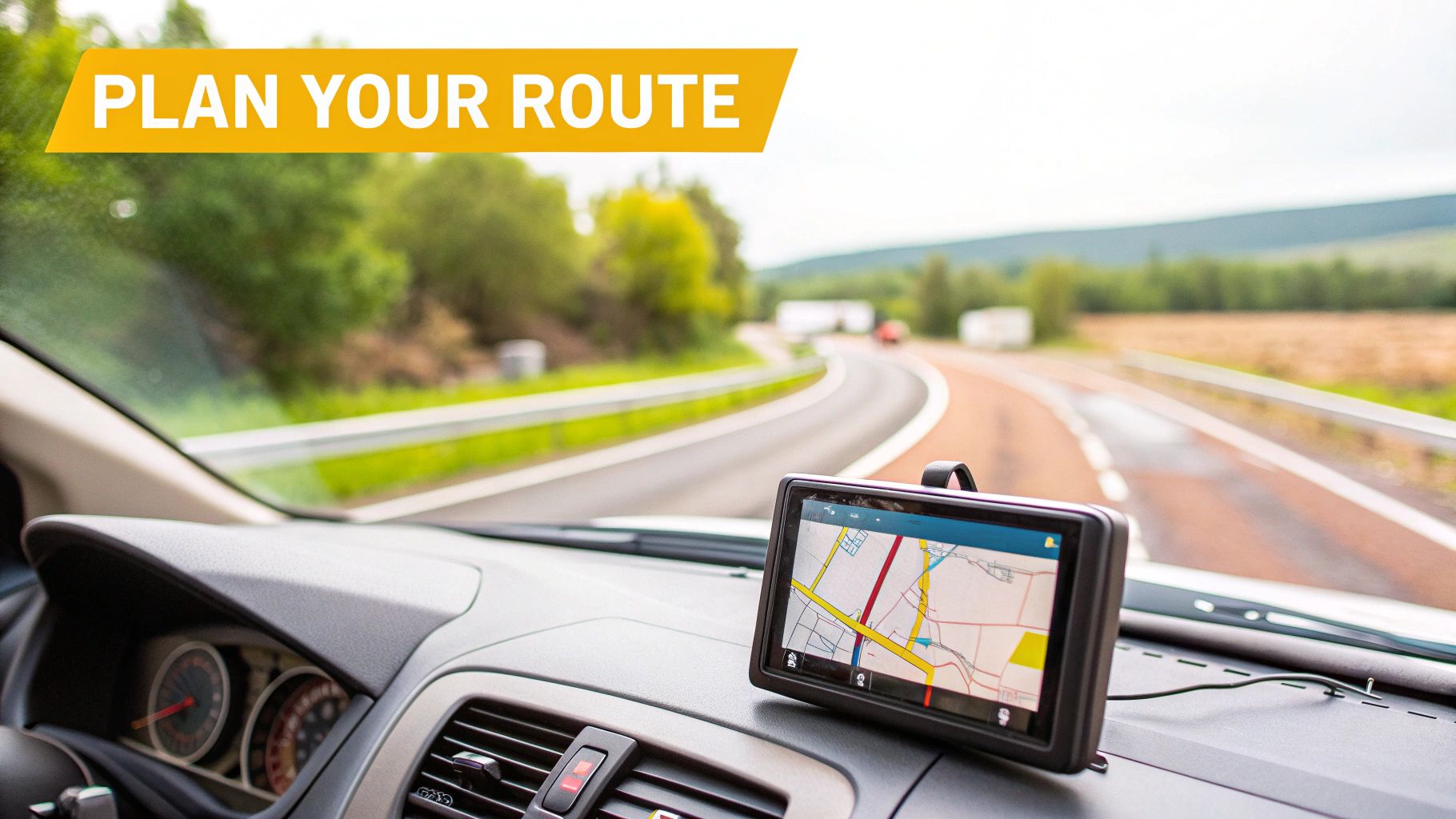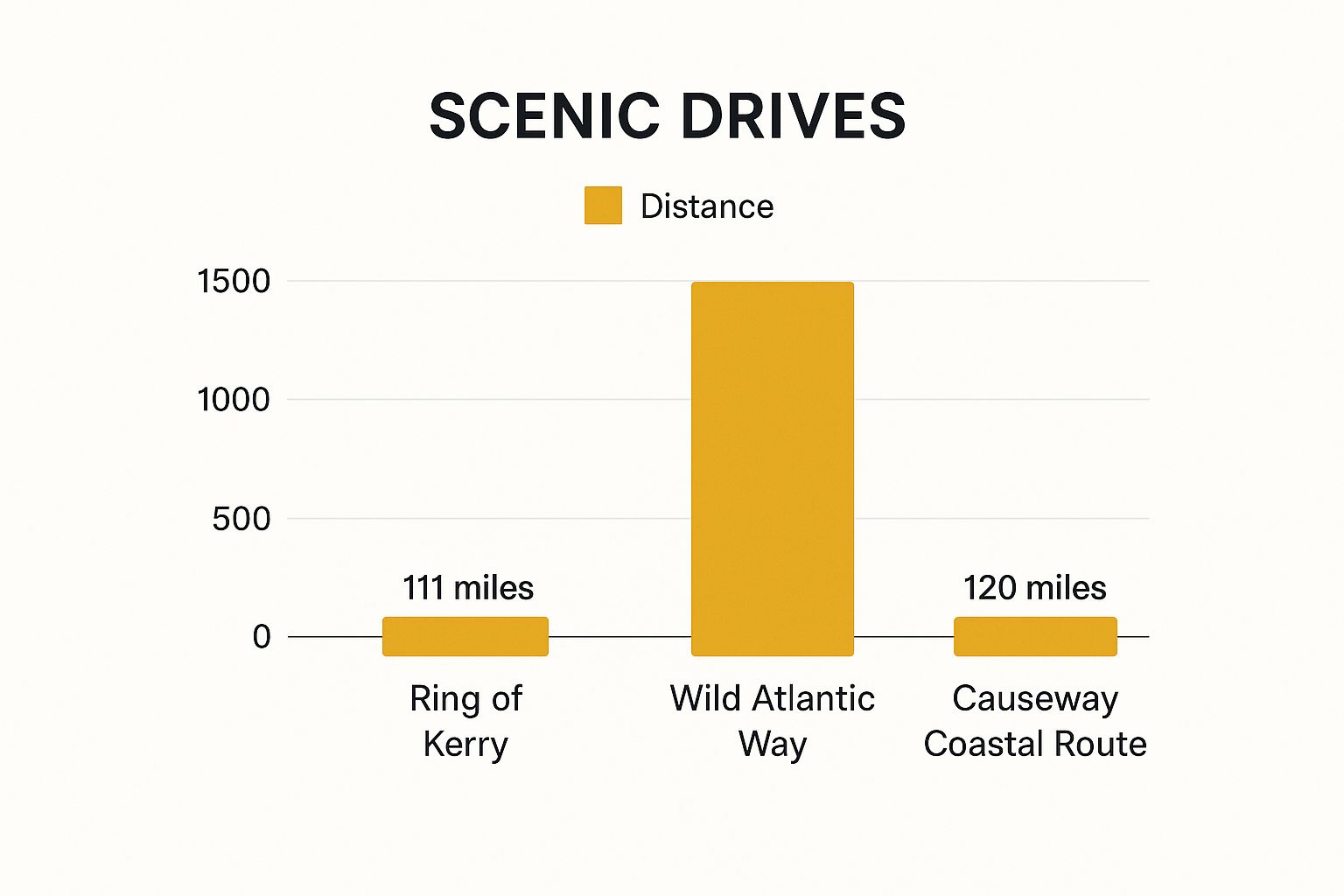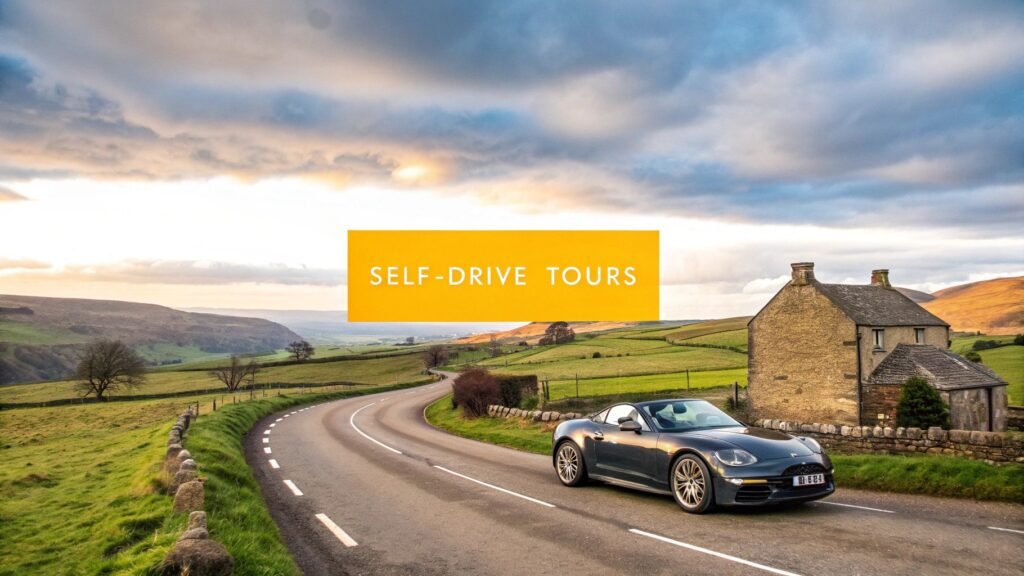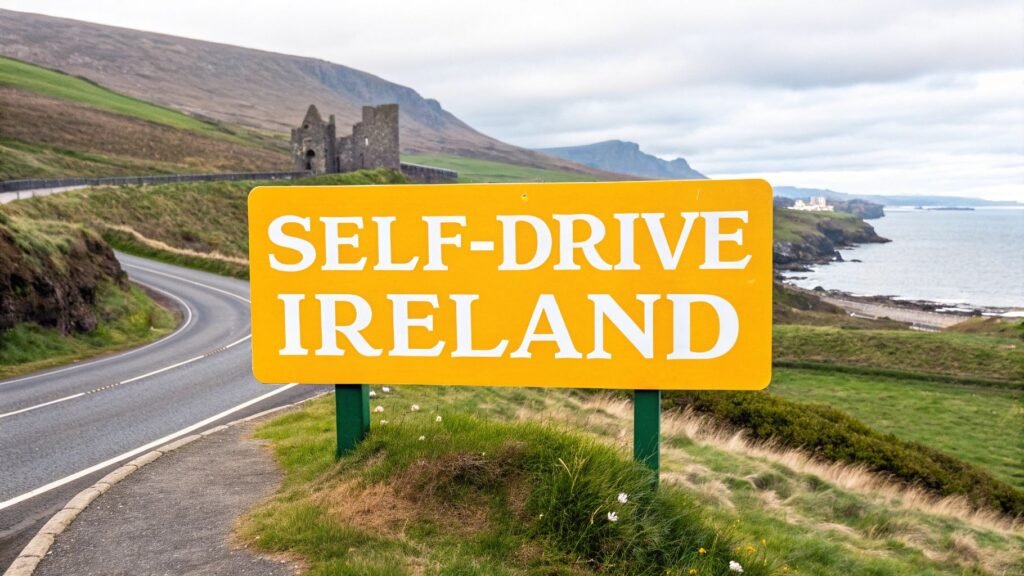Picture this: you’re cruising down a narrow, winding road, a patchwork of green fields on either side, and you spot a sign for a ruined castle not mentioned in any guidebook. You pull over, just because you can. That is the heart and soul of an Ireland self-drive vacation.
It’s about ditching the rigid tour bus schedule and creating a journey that’s entirely yours. Forget being herded from one major site to the next; this is about experiencing the real Emerald Isle at your own pace.
Why a Self-Drive Tour Is the Best Way to See Ireland
Look, guided tours are fine for some, but they often stick to the well-beaten track. A self-drive trip, on the other hand, lets you forge a much deeper, more personal connection with the country. It’s all about the simple joy of the open road and the thrill of spontaneous discovery.
With your own set of wheels, you call the shots. You can linger for an extra hour at a breathtaking viewpoint on the Dingle Peninsula or take a whim-driven detour down a lane that just looks interesting. You decide when to stop, where to grab a bite, and how long you want to soak it all in.
Find Your Own Adventures and Authentic Moments
This is where the real magic happens. Hear a rumour about a trad music session kicking off in a tiny village pub? You can be there in a flash. Spot a bustling farmers' market on the side of the road? Pull over and go have a look. You stop being just a tourist and become part of the fabric of your own Irish adventure.
The best parts of any Irish road trip are almost always the unplanned ones—the chat with a local farmer, the discovery of a deserted beach, or that perfect rainbow stretching over a quiet valley.
This kind of travel lets you get to know the real Ireland, from its show-stopping coastlines to its sleepy rural heartlands. It gives you the freedom to tackle epic routes like the famous Wild Atlantic Way completely on your own terms, spending more time in the places that truly speak to you. You might fall in love with the raw beauty of Connemara or the ancient mysteries of the Boyne Valley and have the flexibility to change your plans on the fly.
You're Supporting Local Irish Communities
Choosing to drive yourself around also has a wonderful ripple effect. Your trip directly supports the small, local communities that make Ireland so special. By exploring the quieter, less-travelled parts of the country, you're putting money into the hands of family-run B&Bs, independent shops, and the local pubs that are the heart of every village.
Tourism is a massive part of the Irish economy. In fact, it recently accounted for 20.4% of Ireland’s GDP. Your adventure helps sustain the very culture and heritage you’ve come all this way to experience.
Crafting Your Perfect Ireland Road Trip Itinerary

The real secret to a brilliant Ireland self-drive vacation isn’t about ticking off every single landmark. It’s about crafting a journey that lets you soak in what matters most to you, without feeling like you’re constantly racing the clock. The aim is to find that sweet spot between driving and discovery—a rhythm that feels like an adventure, not a marathon.
Ireland might look tiny on a map, but its beautiful, winding country roads have a way of stretching out the time. A rookie mistake I see all the time is trying to cram way too much into one trip. Trust me, a 100-mile drive on a narrow Irish B-road is a world away from cruising for 100 miles on a motorway.
The trick is to think geographically and build a route that flows. By grouping your must-see spots by region, you’ll avoid the frustration of backtracking and win back precious hours—time better spent exploring a ruined castle or finding a pub with a great live music session.
Choosing Your Core Route
Before you get lost pinning locations on a map, take a step back and think about the kind of trip you’re dreaming of. Ireland offers a few iconic touring routes that make fantastic backbones for any itinerary.
- The Wild Atlantic Way: This is the big one—a legendary 2,600 km coastal route that snakes its way from Donegal all the way down to Cork. It’s all about dramatic cliffs, windswept beaches, and that raw, rugged beauty Ireland is so famous for.
- Ireland's Ancient East: This route takes you through the lands south of Dublin and east of the River Shannon. It’s a journey through 5,000 years of history, from Neolithic tombs and medieval strongholds to sprawling country estates. If you’re a history buff, this is for you.
- The Causeway Coastal Route: Tucked away in Northern Ireland, this stunning drive connects Belfast with Derry~Londonderry. It’s home to the Giant's Causeway, crumbling castles, and landscapes that might look familiar to film fans. In fact, many people build a whole trip around it, like this 8-day Game of Thrones self-drive tour in Ireland.
Once you’ve settled on a main route, you can start weaving in your own personal detours to those little villages or hidden coves that catch your eye. It’s this mix of a structured plan and spontaneous side-trips that makes for a truly memorable holiday.
How Much Time Do You Really Need?
Your itinerary is going to be shaped more by the length of your stay than anything else. It's a hugely popular getaway, especially for visitors from Great Britain, who consistently make up the largest group of tourists. Recent data from the CSO shows that these visitors, representing about 34-35% of arrivals in the shoulder season, tend to stay for an average of 7.3 nights—a perfect amount of time for a really good regional road trip.
So, what can you realistically see in that time?
My Golden Rule: Never plan for more than 3-4 hours of driving in a single day. This gives you plenty of breathing room for those unexpected photo stops, a leisurely pub lunch, and actually exploring the places you’ve driven so far to see.
Here's a rough guide to help you think about your timeline:
- Got 7 Days? Pick one or two regions and get to know them well. You could hit the highlights of the southern Wild Atlantic Way (think Kerry and Clare) or devote the week to Ireland's Ancient East, exploring Kilkenny, Cashel, and the Wicklow Mountains.
- Got 14 Days? Now you’re talking! This gives you enough time for a more ambitious loop. You could tackle a huge chunk of the Wild Atlantic Way and circle back via Galway and Dublin, or even combine a southern tour with a drive up the Causeway Coast into Northern Ireland.
Let's put this into practice. Say you have one week and your heart is set on the famous Wild Atlantic Way. Instead of a frantic dash along its entire length, you’ll have a much better time by focusing on one spectacular section.
Sample 7-Day Wild Atlantic Way Itinerary
Here’s a quick look at how you could structure a week to get the most out of one of Ireland's most scenic drives without feeling rushed off your feet.
| Day | Route Section | Key Stops | Approx. Driving Time |
|---|---|---|---|
| 1 | Arrival in Shannon | Pick up car, settle into accommodation near County Clare. | Minimal |
| 2 | Cliffs of Moher & The Burren | Explore the cliffs, then the unique limestone landscape of the Burren. | 2-3 hours |
| 3 | Drive to Dingle | Scenic coastal drive to the vibrant Dingle Peninsula. | 3-4 hours |
| 4 | Slea Head Drive | Loop around the stunning Slea Head, visiting ancient sites. | 2-3 hours |
| 5 | Dingle Exploration | Enjoy the town, go sea kayaking, or hike. | Minimal |
| 6 | Killarney National Park | Drive through the park, see Muckross House & Torc Waterfall. | 2-3 hours |
| 7 | Return to Shannon | Easy drive back to the airport for departure. | 2 hours |
This kind of approach ensures your holiday is filled with moments of real discovery, not just miles on the road. Plan smart, and your Ireland road trip will be unforgettable for all the right reasons.
Getting Your Head Around Car Hire and Insurance in Ireland

Picking the right car is probably one of the biggest decisions you'll make for your Ireland self-drive vacation. It's your ticket to finding those incredible spots that aren't on the main tourist trail, but let's be honest, the whole process can feel a bit overwhelming. Let's walk through everything you need to know about hiring a car, from the documents you'll need to the insurance that will actually let you relax and enjoy the drive.
First things first, get your paperwork in order before you even think about comparing prices. For most UK drivers, it’s a breeze. You'll need a valid photocard driving licence, a passport for ID, and critically, a credit card in the lead driver's name. This is for the security deposit, and it’s non-negotiable—debit cards are almost never accepted for the hold.
Choosing the Right Car for Winding Irish Roads
I can't stress this enough: Ireland's rural roads are famously narrow, often with nothing but an old stone wall or a thick hedge between you and a field of sheep. A big, roomy car might sound great on the motorway, but a smaller, more compact vehicle is your best friend on those country lanes. Think VW Polo or Ford Focus—something you can confidently manoeuvre through tight gaps without holding your breath.
The other big choice is transmission. Automatics are getting more common, but manuals are still the default for most rental companies in Ireland, and they’re almost always cheaper. If you're not 100% comfortable with a stick shift, I'd strongly recommend paying a bit extra for an automatic. It'll save you a lot of stress on those steep, unfamiliar hills.
My Two Cents: Don’t get lured in by a super-low headline price. Always dig into what's actually included. Some of the "bargain" deals sting you with hidden fees for adding a second driver, airport pick-up surcharges, or tight mileage limits that can really add up.
A lot of people find that using a trusted broker or booking one of the comprehensive self-drive tours cuts out all this hassle. The car and all the necessary cover are usually bundled in, meaning you don't have to spend your holiday worrying about the fine print.
Demystifying Irish Car Hire Insurance
This is where things can get confusing, but it's vital to understand. By law, every rental car in Ireland includes basic third-party liability. But what you really need to pay attention to is the excess—that’s the chunk of money you're on the hook for if the car gets damaged or stolen. This figure can be shockingly high, often €2,000-€3,000.
To avoid that massive potential bill, rental companies offer a Collision Damage Waiver (CDW). It’s not insurance in the traditional sense; it’s basically a promise from the rental company that they won't charge you the full cost of repairs. But here's the catch: even with standard CDW, you’re still liable for a hefty excess, usually around €1,500-€2,500.
This brings us to Super CDW (you might also see it called Excess Protection). It's an optional extra you pay per day, and it's designed to reduce your excess to zero, or a much more manageable amount like €100-€250. It might feel like an annoying upsell at the counter, but for complete peace of mind, it’s worth its weight in gold. A minor scrape against a stone wall—which is incredibly easy to do—won't end up costing you a fortune.
Here's how the options stack up:
- Basic Insurance (Included): Only covers damage to other people's property. You are responsible for the entire cost of damage to your rental car.
- Standard CDW (Often Included): Limits your liability to a fixed excess (e.g., €2,000), but you'll still pay that amount for any significant damage.
- Super CDW (Optional Extra): The best option for peace of mind. It cuts your excess down to almost nothing (often zero) and usually covers things like tyres and windscreens, which standard CDW often excludes.
Planning a Trip Across the Border?
Thinking of nipping up to Northern Ireland from the Republic? It's a fantastic idea and the border is completely seamless, but you must tell your rental company in advance. Most will add a small cross-border fee, which ensures your insurance and breakdown cover are still valid once you're in the UK.
If you don't declare it, your insurance could be voided the second you cross the border, leaving you totally exposed. It’s a tiny bit of admin that provides essential protection for a worry-free tour of the whole island.
Mastering the Roads: A Driving Guide for Visitors
While driving on the left will feel second nature to visitors from the UK, Irish roads have their own distinct personality. Getting to grips with a few key differences will make your Ireland self-drive vacation smoother, safer, and far more enjoyable. Think of it less as relearning how to drive and more about adapting to the local rhythm of the road.
The first thing you’ll notice is the sheer variety of tarmac you’ll cover. One minute you could be cruising along a modern M-road (motorway), and the next, you're carefully navigating a narrow rural lane where grass grows right down the middle. These smaller roads, often hemmed in by ancient stone walls, demand a slower pace and your full attention.
Navigating Speed Limits and Signage
When you're driving in the Republic of Ireland, keep this in mind: all road signs and speed limits are in kilometres per hour (km/h). This is a crucial detail to remember as you travel.
As a general guide:
- Motorways have a speed limit of 120 km/h.
- National roads are usually 100 km/h.
- Regional roads drop to 80 km/h.
- Urban and built-up areas are typically 50 km/h or even lower.
Should your journey take you into Northern Ireland, everything flips. Road signs change to show distances in miles, and speed limits are in miles per hour (mph), just like back home. A modern sat-nav will usually handle this switch for you, but it's essential to be mentally prepared for the change to avoid any confusion.
A Note on Rural Driving: The unwritten rule of Irish rural driving is simple: patience. If a tractor pulls out in front of you, just relax and enjoy the scenery. Overtaking can be incredibly risky on tight, winding roads, and you'll often find local drivers will pull over to let you pass as soon as it's safe to do so.
This visual comparison of Ireland's most famous scenic drives gives you a real sense of the scale of these iconic routes.

You can see the immense scale of the Wild Atlantic Way, which dwarfs the more contained, but equally beautiful, Ring of Kerry and Causeway Coastal Route.
Unwritten Rules and Road Etiquette
Beyond the official regulations, a few local customs will make your driving experience much easier. On the single-lane roads common in stunning places like the Dingle Peninsula or Connemara, good etiquette is everything. The driver who reaches a designated passing place first should be the one to pull in and wait. A friendly wave of acknowledgement is always appreciated.
Toll roads are mostly found on the major motorways around Dublin and other large cities. Most have traditional booths where you can pay with cash or card. The main exception is Dublin's M50, which uses a barrier-free system. Cameras record your registration number, and you must pay the toll online or at a designated Payzone outlet by 8 pm the following day. Forgetting to do this can lead to some surprisingly hefty fines.
Finally, and this is non-negotiable, Ireland has extremely strict drink-driving laws. The blood alcohol limit is so low that it's effectively zero for professional and learner drivers. For everyone else, it's still very low. The only safe approach is to avoid alcohol completely if you plan on getting behind the wheel.
Parking and Legal Considerations
When parking in towns and cities, you'll typically be looking for pay-and-display machines. Look for the ticket machines on the street or check if a parking app is available. And always be aware of double yellow lines—they mean no parking at any time.
As you plan your route, it helps to be aware of the key differences you'll encounter if you cross the border between the Republic and the North.
Driving in the Republic vs. Northern Ireland: A Quick Guide
Here’s a quick-glance table to help you remember the main changes when driving across the border on the island of Ireland.
| Feature | Republic of Ireland | Northern Ireland |
|---|---|---|
| Speed/Distance Unit | Kilometres (km/h) | Miles (mph) |
| Currency for Tolls/Parking | Euro (€) | Pound Sterling (£) |
| Road Markings | Yellow lines for hard shoulders | White lines for hard shoulders |
| Emergency Number | 999 or 112 | 999 or 112 |
Embracing these small nuances will quickly build your confidence behind the wheel, allowing you to relax and focus on the spectacular views and the absolute freedom of the open road.
Choosing Your Accommodation, From Castles to Cosy B&Bs

Where you rest your head each night isn't just a practical detail; it's a huge part of your Ireland self-drive adventure. From a friendly guesthouse where the owner knows every local secret to a grand castle hotel that transports you back in time, every choice adds its own unique flavour to your trip.
Think about the kind of experience you’re after. Each style of accommodation offers something different:
- Traditional B&Bs: The heart and soul of Irish hospitality. You’ll get a hearty breakfast to set you up for the day and priceless local tips from hosts who have likely lived in the village their entire lives.
- City hotels: Reliable, convenient, and right in the middle of the action. They're perfect for a night or two when you’re flying in or out, before you hit those narrow country lanes.
- Self-catering cottages: Want the freedom to cook your own meals and come and go as you please? A cottage is a fantastic option, especially for families or anyone craving a bit more independence.
- Historic castles: This is your chance to live out a fairytale. Expect ancient stone walls, maybe a suit of armour in the hall, and sprawling, impressive estates that whisper stories of centuries past.
- Rustic farmhouses: Get a real taste of rural life. Waking up to the sound of sheep and tucking into a breakfast made with produce from the farm is an experience you won't forget.
Local Insights and Booking Strategies
One of the biggest questions I get is how much to plan in advance. My advice? Book your first and last nights, especially if you’re near a major airport, as this takes the stress out of car hire and transfers. But don’t over-schedule the middle of your trip. You need to leave room for the unexpected.
Here are a few tactics that have always worked for me to get the right balance between a plan and pure spontaneity:
- Secure your bookends: Always reserve your accommodation for your arrival and departure nights. It just makes life easier.
- Leave the middle open: If you stumble upon a village you absolutely love, you’ll have the freedom to find a local B&B and stay an extra night. This is where the real magic happens.
- Check cancellation policies: Life happens. Many smaller B&Bs have very reasonable policies, often allowing free cancellation up to a week before you arrive.
- Use trusted platforms: Websites like Booking.com are great, but also check out the local tourist board sites. You can often find hidden gems and get fair rates by booking direct.
An old travel writer I know, Aisling O’Brien, calls this the “flexible core” approach. You secure your anchors at the start and end, and then let the road decide the rest. It’s a brilliant way to travel.
That Dream Castle Stay
Sleeping in a centuries-old castle is a truly magical experience, but it does require a bit more forethought. These places don't have hundreds of rooms, and they book up fast, particularly in the summer.
To avoid disappointment:
- Book at least three months in advance for a summer stay.
- Ask about meal options when you book. Some castle packages include a fantastic three-course dinner.
- Check if they have any events on, like weddings. This can sometimes limit your access to shared spaces.
Here’s a quick comparison to help you decide:
| Feature | B&B | Castle |
|---|---|---|
| Price per night | €80–€120 | €180–€300 |
| Typical breakfast | Included local spread | À la carte, fine dining |
| Atmosphere | Homely and social | Grand and historic |
| Cancellation window | 7–14 days before arrival | 30–60 days before arrival |
Rustic Farmhouses and Self-Catering Cottages
For a truly authentic, down-to-earth vibe, nothing beats a farmhouse stay. Many hosts are farmers who grow their own food and are happy to let you get a glimpse into their daily lives.
To find these unique properties, you sometimes have to dig a little deeper:
- Look for Airbnb listings with “farmstay” in the description and a rating of 4.8+.
- Pick up local tourism magazines when you arrive; they often highlight off-the-beaten-path options.
- Search for dedicated social media groups for Irish cottage rentals.
Recent data from Tourism Northern Ireland research shows a growing trend towards this kind of travel. While hotel occupancy among British visitors grew by 11%, self-catering bookings shot up by 8%, showing that more and more people are craving flexible, authentic stays.
Making It All Fit Your Itinerary
Ultimately, your route should dictate your lodging choices. If you’re planning to spend a few days exploring a dramatic coastal stretch like the Wild Atlantic Way, find a seaside cottage. If you’re heading inland to drive through rolling green farmland, a farmhouse stay makes so much more sense than a city hotel.
Map out your rough stops before you start booking. It’ll save you from realising too late that you’ve got a long, frustrating detour just to find an open room for the night.
Pairing Your Stays with Local Experiences
To really get the most out of your trip, try to pair your accommodation with nearby activities. For example, if you book a seaside B&B near the fishing village of Ballycotton, you’re perfectly placed for a breathtaking coastal walk at sunrise.
Staying in a farm cottage on the edge of the Burren National Park means you can get out for an early morning hike and have the otherworldly landscape all to yourself before the day-trippers arrive. And booking a castle in County Cork? Make sure you ask the staff for their recommendation on the best local pub for dinner and live music.
When you’re booking your room, see if the hosts offer any activity packages. You can often get great deals on things like boat trips, horseback riding, or tickets to a local music night.
Answering Your Final Questions About Driving in Ireland
Even the most organised traveller has those



